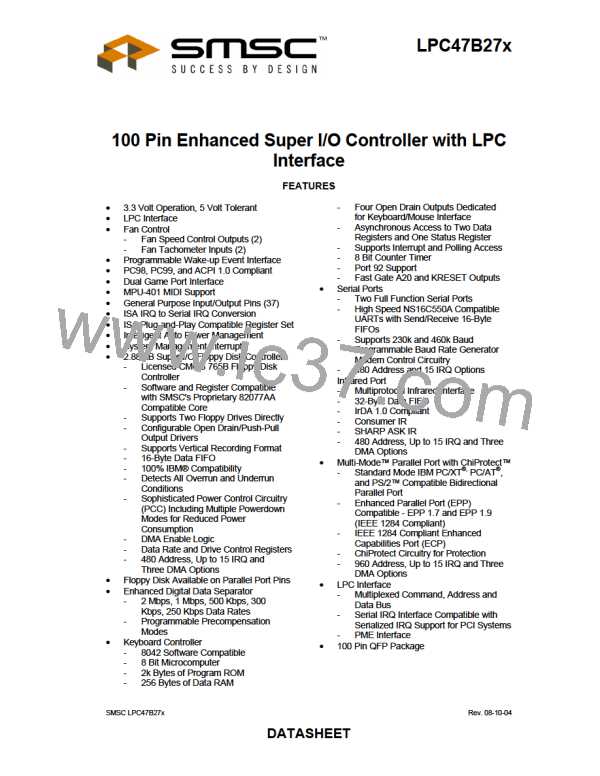EXTERNAL KEYBOARD AND MOUSE INTERFACE
Industry-standard PC-AT-compatible keyboards employ a two-wire, bidirectional TTL interface for data
transmission. Several sources also supply PS/2 mouse products that employ the same type of interface.
To facilitate system expansion, the LPC47B27x provides four signal pins that may be used to implement
this interface directly for an external keyboard and mouse.
The LPC47B27x has four high-drive, open-drain output, bidirectional port pins that can be used for
external serial interfaces, such as external keyboard and PS/2-type mouse interfaces. They are KCLK,
KDAT, MCLK, and MDAT. P26 is inverted and output as KCLK. The KCLK pin is connected to TEST0.
P27 is inverted and output as KDAT. The KDAT pin is connected to P10. P23 is inverted and output as
MCLK. The MCLK pin is connected to TEST1. P22 is inverted and output as MDAT. The MDAT pin is
connected to P11. NOTE: External pull-ups may be required.
KEYBOARD POWER MANAGEMENT
The keyboard provides support for two power-saving modes: soft powerdown mode and hard powerdown
mode. In soft powerdown mode, the clock to the ALU is stopped but the timer/counter and interrupts are
still active. In hard power down mode the clock to the 8042 is stopped.
Soft Power Down Mode
This mode is entered by executing a HALT instruction. The execution of program code is halted until
either RESET is driven active or a data byte is written to the DBBIN register by a master CPU. If this
mode is exited using the interrupt, and the IBF interrupt is enabled, then program execution resumes with
a CALL to the interrupt routine, otherwise the next instruction is executed. If it is exited using RESET then
a normal reset sequence is initiated and program execution starts from program memory location 0.
Hard Power Down Mode
This mode is entered by executing a STOP instruction. The oscillator is stopped by disabling the
oscillator driver cell. When either RESET is driven active or a data byte is written to the DBBIN register
by a master CPU, this mode will be exited (as above). However, as the oscillator cell will require an
initialization time, either RESET must be held active for sufficient time to allow the oscillator to stabilize.
Program execution will resume as above.
INTERRUPTS
The LPC47B27x provides the two 8042 interrupts: IBF and the Timer/Counter Overflow.
MEMORY CONFIGURATIONS
The LPC47B27x provides 2K of on-chip ROM and 256 bytes of on-chip RAM.
Register Definitions
Host I/F Data Register
The Input Data register and Output Data register are each 8 bits wide. A write to this 8 bit register will load
the Keyboard Data Read Buffer, set the OBF flag and set the KIRQ output if enabled. A read of this
register will read the data from the Keyboard Data or Command Write Buffer and clear the IBF flag. Refer
to the KIRQ and Status register descriptions for more information.
Host I/F Status Register
The Status register is 8 bits wide. Table 53 shows the contents of the Status register.
Table 53 - Status Register
D7
UD
D6
UD
D5
UD
D4
D3
D2
D1
IBF
D0
OBF
UD
C/D
UD
Status Register
This register is cleared on a reset. This register is read-only for the Host and read/write by the LPC47B27x
CPU.
UD
Writable by LPC47B27x CPU. These bits are user-definable.
C/D
(Command Data)-This bit specifies whether the input data register contains data or a command
(0 = data, 1 = command). During a host data/command write operation, this bit is set to "1" if
SA2 = 1 or reset to "0" if SA2 = 0.
SMSC LPC47B27x
- 102 -
Rev. 08-10-04
DATASHEET

 SMSC [ SMSC CORPORATION ]
SMSC [ SMSC CORPORATION ]